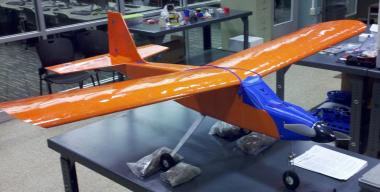President Obama highlighted 3-D printing in last week’s State of the Union address, calling it the technology that “has the potential to revolutionize the way we make almost everything.”
Three-dimensional printing is the production or “printing” of actual objects, such as toys or parts for devices, by using a machine that traces out layers of melted plastic in specific shapes until it builds up a piece exactly according to the size and dimensions specified in a computer-aided drawing produced by a designer. Increasingly, with user-friendly computer programs and 3-D printers, the designer can be anybody. Eventually, almost any object or parts for objects, may become 3-D printable, including body implants, in a range of materials, including medals.
Engineers and engineering students at the University of Virginia are using sophisticated 3-D printing technology to make an array of objects, including a plastic airplane for a Department of the Army project.
David Sheffler, a U.Va. professor of mechanical and aerospace engineering in the School of Engineering and Applied Science and a 20-year veteran of the aerospace industry, teaches 3-D printing to engineering students. He recently discussed the future of 3-D printing in industry and society.
Q: Currently 3-D printing is used for rapid prototyping of objects in small quantities. How would it be used in large-scale manufacturing, as President Obama seems to suggest?
Sheffler: Currently the technology is best suited to prototyping, production of geometries that otherwise could not be manufactured cost effectively – production runs of limited quantity – or for items that would benefit from custom tailoring. Advancements are needed to reduce manufacturing times in order to compete with more traditional processes such as injection molding for production quantities in the thousands. Once these hurdles are overcome, this technology has the potential to revolutionize the way we manufacture products.
Q: What is the future of this technology? Will it become a routine way to manufacture?
Sheffler: Many have already started talking about the typical household having a 3-D printer in the next five to 10 years. Products would be purchased online in the form of a downloaded file that would be printed out in the home. It might be possible eventually to print your own shoes after scanning your feet, or maybe printing your clothes. Some believe this technology stands about where personal computers were in the mid-1980s in terms of maturity. Most of the uses probably have not yet been conceived.
Q: Will the U.S. lead the way, or could this bring manufacturing to nearly anywhere?
Sheffler: Now that patents on the initial products in the industry are running out, many others are developing machines and advancing the technology. It’s anyone’s guess as to who might start to capture the market.
Q: What are the dangers of this, such as people printing weapons or drones?
Sheffler: As with any technology, there is the potential for good and harm to result. Weapons and drones used for killing and spying are dominating the media at this time. There are many more peaceful constructive uses for the technology, the potentials of which are only just being realized.
Q: What is U.Va. doing in 3-D printing?
Sheffler: U.Va. has created a rapid prototyping center with funding from Rolls-Royce that includes seven 3-D printers, among other capabilities. We are incorporating this technology into the curricula through courses like “Mechatronics” and “Jet Engine Manufacturing.” We offer use of the center to students and also as a fee-based cost center for anyone throughout the world to submit a model on a dedicated Web page and we print the product and ship it to them.
Media Contact
Article Information
February 18, 2013
/content/uva-professor-says-3-d-printing-could-revolutionize-manufacturing

